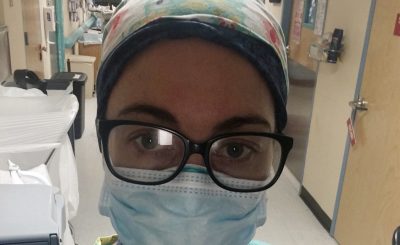Dr. Anna Rogers ‘03 took a job at a hospital on the border of the Navajo Reservation because she wanted to care for the underserved. Six months later, she found herself treating COVID-19 patients in the nation’s hardest hit area for the pandemic.
“It’s been challenging, emotionally and physically,” said Rogers, who since last October has worked at Gallup Indian Medical Center in northwestern New Mexico. “It has been isolating personally and professionally, and it’s been hard to watch the devastation in the community. There’s not a family that hasn’t lost a loved one in the Navajo Nation.”
About the size of West Virginia, the Navajo Nation in New Mexico, Arizona and Utah is home to about 175,000 people. By mid-May, the Navajo had an infection rate of more than 3.4 percent – the highest in the nation — and more than 6,000 confirmed cases, according to the Navajo Nation Department of Health. By comparison, New York state had an infection rate of 1.9 percent.
As of earlier this month, 9,800 had tested positive for the coronavirus; 500 had died and 7,100 recovered.
The coronavirus was so devastating, experts say, because of severely lacking infrastructure on the reservation. An estimated 30 percent of homes don’t have running water, and over half of Navajo communities lack broadband access. A lack of healthy food options, overcrowded housing and high rates of heart disease, diabetes and obesity compounded the problem.
“They have such strong family networks and live in multigenerational homes so it’s difficult to isolate,” Rogers said. “Those communities that have been systematically marginalized are a setup for a respiratory virus to be particularly bad because of difficulty isolating and keeping their community protected.”
She works for the U.S. Indian Health Services, a government agency that provides care for 567 federally recognized American Indian and Alaska Native tribes and their descendants, or about 2.2 million people. Rogers spoke about her COVID experience as a private citizen and not an employee of the federal government.
“COVID affected the Navajo Nation disproportionally,” she said. “We very quickly had a significant number of cases in the emergency room and admitted to the hospital. The sickest were often flown to Albuquerque. Ultimately, the state set up a hub, where patients were sent all over the state – Santa Fe, Farmington and Las Cruces.”
Gallup’s 99-bed hospital had up to 45 COVID patients admitted to the inpatient wards, forcing Rogers to work 10- to 12-hour days. She also had to protect herself and her staff; Rogers tested negative for COVID six times. In addition, the hospital didn’t allow visitation, but provided video visits for patients and their families.
“I think the hardest part is that patients were alone and scared, and their families were at home and couldn’t be at their bedside,” she said.
Mother’s Day was the hardest.
“To have a family on a Zoom meeting, having to say goodbye to their grandmother on Mother’s Day… knowing Mother’s Day would be difficult forever, knowing their grandmother had to die alone without family in the hospital in a culture where when a loved one dies, there are often 10 to 20 family members in their room with them.”
To compound matters, Rogers lost an uncle to COVID two weeks ago.
“I, too, am grieving the loss of a family member to COVID-19,” she said.
For Rogers, serving in her birthplace of Gallup is sort of a homecoming. Her family moved to California when she was just 5 and she returned to New Mexico to attend UWC-USA.
A 2012 graduate of University of Southern California Keck School of Medicine, Rogers completed her residency in family medicine at Ventura County Medical Center and remained with the hospital for two additional years before moving to Gallup.
“I had intended to take a job with Indian Health Service and knew I wanted to work in the Southwest,” she said. “I’m interested in global health, and at some point will work abroad and this allowed me to serve a very underserved population.”
“I think it’s important to provide access to excellent health care to those who need it most,” Rogers continued.
Her experience at the United World College-USA is why she went into medicine.
“It’s the foundation for why I do what I do,” the 36-year-old said. “It’s a big part of why I came to work for the IHS. I started out wanting to go into a career where I could make a difference.”
“I was expecting to work in a place, where I was navigating cultural differences and working with a population in which I’m not familiar with the language or the culture” she continued. “No one expected a pandemic.”

